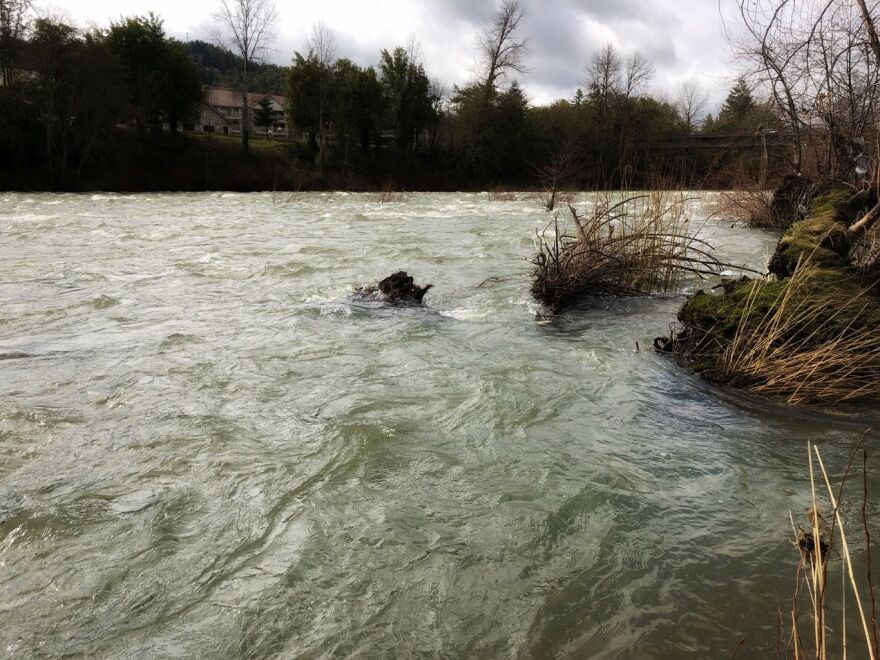There’s concern over the latest count of spring chinook salmon in the South Lower Umpqua River. As KLCC’s Brian Bull reports, fishermen, conservation officials, and local tribes hope the fish’s numbers rebound…and blame a number of factors.
The Lower Umpqua is revered for its natural beauty and fishing. In a 2013 episode of “The American Outdoorsman”, host Mark Tobin and guide, Gary Lewis, manage to hook a chinook salmon after a lively fight.

“Oh, lookit that! What a pretty fish!” exclaims Tobin.
The 18-lb. female is held up to the camera, before being released back into the water so it can release its eggs. It’s a conscientious gesture that conservation-minded anglers do, though it may not be enough.
Bull: “Here along the banks of the South Umpqua River, all looks fine and normal but late last year, Fish and Wildlife Officials say they only counted 28 spring chinook salmon coming back to their natal pools, one of the lowest counts on record.”

“They’re on the precipice of perhaps going extinct,” says Jeffrey Dose. The retired fisheries biologist says it’s the second lowest count seen in four decades, and believes maintaining adequate gravel beds, shade, and water quality can help the fish escape a fate experienced by another species.
“A little historical perspective: the South Umpqua in 1937, a survey by the U.S. Bureau of Fisheries found abundant summer steelhead, at South Umpqua Falls,” says Dose.

“And they are now extinct. So I think that we’re kinda on that trajectory.”
Not everyone agrees.
"This is clearly bad, but it’s not doomsday,” says Jason Brandt. He’s a fish biologist with the Oregon Department of Fish and Wildlife in Roseburg. Generally the preferred numbers the ODFW would like to see is around 600, though the species has averaged 170 per count.
“Going from a couple hundred to 28 was pretty significant.”
Brandt says a number of factors could be at play, from warming oceans to low snow pack. With another annual count coming up in late summer, he’s cautiously optimistic.
“Hopefully we’ll see a turnaround this next year,” he says. “And if we do see a similar low count this next year, then we really have to start ratcheting up and figuring out exactly what’s gonna be done.”

Those next steps are of great interest to Stanley Petrowski. He’s President of Umpqua Watersheds and chair of the South Umpqua Rural Community Partnership, which are both exploring aquatic habitat restoration for the spring chinook salmon.
Petrowski partly blames another fish for their decline.
“When these young juvenile salmon migrate downstream from their spawning waters, they have to run the gamut down to the coast,” he explains.
“The smallmouth bass and largemouth bass -a predatory, non-native fish- they are slaughtering the spring chinook.”

There is data suggesting that the current juvie salmon numbers are actually good, if not improving, says Greg Huchko, a fish biologist with the Umpqua District.
“In 2017, which would be the most recent, the total juvenile count was around 12,000 fish. Prior to that we were looking at 3,000-4,000. So it did take a nice bump for us.”
Huchko says such juveniles face acidification of the oceans, among other factors mentioned.
Beyond conservation agencies and groups, others have a stake in the welfare of spring chinook in the South Lower Umpqua. Among them is Bob Hoehne, an avid fisherman.
“Means so much for me to go out in nature,” says Bob Hoehne, an avid fisherman. “And have the luck to maybe catch one.

“I feel like it is a spiritual thing because I have fed my family, and my neighbors and friends with these salmon, for years now.”
And the Cow Creek Tribe has annual coming of age ceremonies with the fish, according to Kelly Coates.
“We return the bones of the salmon to the river, so that the salmon will return,” she tells KLCC.
“The ceremony itself is very important for many reasons. For our young men, it’s their rite of passage. And it also instills the respect and gratitude on, to each generation.”
Coates is the Cow Creek Tribe’s water and environmental resources manager. She says to improve the spring chinook’s numbers, it’ll take a collaborative approach with many regional partners. But if successful, it’ll help a fish essential to the ecosystem.
“They bring in marine-derived nutrients from the ocean, and when they spawn and die, those nutrients get incorporated into the river system and help make it more productive for not only the aquatic species, but also the species that use the riparian areas as well.”
On a more personal level, Coates says she’d like to bring her own children to see the fish, and hopes the spring chinook salmon numbers rebound.

“I’ve been working with these fish for a very long time,” she says.
“It would be really sad if our future generations weren’t able to have that kind of connection.”
But as to whether or not the fish’s numbers are dwindling or coming back…that won’t be known until summer’s end, when Fish and Wildlife officials conduct their next annual spring chinook count.
Copyright 2019, KLCC.






